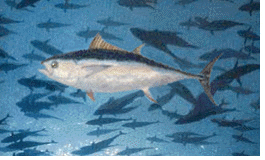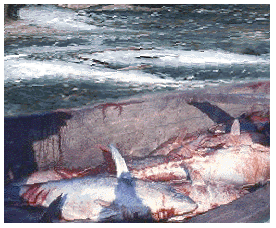...Best of Sicily presents... Best of Sicily Magazine. ... Dedicated to Sicilian art, culture, history, people, places and all things Sicilian. |
by Roberta Gangi | ||
Magazine Index Best of Sicily Arts & Culture Fashion Food & Wine History & Society About Us Travel Faqs Contact Map of Sicily |
The keys to a successful mattanza, apart from the obvious questions
of supply (overfishing has reduced the number of larger tuna in
recent years) and weather, are organisation and technique. A series
of vast nets are lowered into the water. The tuna are captured
in successive nets which are gradually restricted in size and
raised toward the surface, where the fish are attacked with what
might be described as large spears in a Reaching 4.3 meters (14 feet) in length and weighing as much as 800 kilograms (1800 pounds), the bluefin is the largest tuna, surpassing the skipjack, albacore, yellowfin and bigeye. Unlike these other worldwide species, the bluefin lives in the Atlantic and Mediterranean. The network of net chambers is called an isola (island). One of the interesting things about the mattanza is the team effort of the numerous fishermen involved in each catch. From his boat, the rais directs the work of the men in the other small boats. Because a mattanza is the catch of an entire school of fish, dozens of tuna may be captured. The ambience of bloody water and particularly large fish, which may be compared to cattle or large game, leaves one with a singular impression. There's nothing like watching the fish struggle as they are herded into ever smaller, shallower net chambers (the final one is called the "chamber of death") and finally lifted onto the boats. Indeed, the term mattanza has found its way into the Italian vernacular as a synonym for "massacre." Just how long the mattanza itself survives remains to be seen. As time passes, the tuna are diminishing in size and numbers, while demand increases in world markets. This has prompted legal restrictions. A hundred years ago, there were dozens of small "tonnare" (tuna canneries) along the Sicilian coasts, though the word "tonnara" originally referred to the complex series of nets used in tuna fishing during the mattanza. The occupation of tuna fishing was more widespread, with hundreds of tonnarotti (tuna fishermen) throughout Sicily. Tunny fishing has usually been a seasonal profession in Sicily, with the tonnarotti catching other fish during the autumn and winter. Breaded fried tuna steaks are a traditional Sicilian specialty. Tuna steaks are also good simply grilled. For something different, try it "Japanese-Sicilian" style --raw sprinkled with varietal extra virgin olive oil and freshest lemon juice. About the Author: Roberta Gangi has written numerous articles and one book dealing with Italian cultural and culinary history, and several food and wine articles for Best of Sicily Magazine. | |
Top of Page |
 For hundreds of years, fishermen in Sicily and Sardinia have used dense nets to capture the Mediterranean bluefin tuna (thunnus
thinnus) in a quasi-spiritual procedure known as the mattanza.
This takes place in May and June, when the giant fish swim past
the coasts. In Sicily, the few remaining mattanzas take place
off the island's western point among the Egadi Islands. The term
"mattanza" comes to us from an old Spanish word, matar,
meaning "to kill." Many terms, such as rais (head
fisherman of the mattanza), are actually Arabic in origin, introduced
in the ninth century when, during the Arab domination of Sicily,
the technique became popular. There are indications, however,
that it is much older, possibly originating, in some form, in
the Phoenician or Carthaginian era. Averaging over two hundred kilograms
(over four hundred pounds), the fish are now popular in the Japanese
market, where the delicious red meat is used in sashimi and sushi.
It must be said that this fresh tasty meat is a breed apart from
the bland whitish stuff sold in cans. Bluefin, many of which escape
into the Atlantic, may also be consumed young.
For hundreds of years, fishermen in Sicily and Sardinia have used dense nets to capture the Mediterranean bluefin tuna (thunnus
thinnus) in a quasi-spiritual procedure known as the mattanza.
This takes place in May and June, when the giant fish swim past
the coasts. In Sicily, the few remaining mattanzas take place
off the island's western point among the Egadi Islands. The term
"mattanza" comes to us from an old Spanish word, matar,
meaning "to kill." Many terms, such as rais (head
fisherman of the mattanza), are actually Arabic in origin, introduced
in the ninth century when, during the Arab domination of Sicily,
the technique became popular. There are indications, however,
that it is much older, possibly originating, in some form, in
the Phoenician or Carthaginian era. Averaging over two hundred kilograms
(over four hundred pounds), the fish are now popular in the Japanese
market, where the delicious red meat is used in sashimi and sushi.
It must be said that this fresh tasty meat is a breed apart from
the bland whitish stuff sold in cans. Bluefin, many of which escape
into the Atlantic, may also be consumed young. sophisticated trap system.
sophisticated trap system.